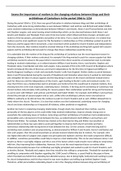Assess the importance of motives in the changing relations between kings and their
archbishops of Canterbury in the period 1066 to 1216
During the period 1066 to 1216, there was great fluctuation in relations between kings and their archbishops of
Canterbury with some strong relationships as seen between William I and Lanfranc and Richard and Hubert Walter,
some strained relationships as demonstrated between William II and Anselm, Henry II and Thomas Becket and John
and Stephen Langton, and some heaving mixed relationships which can be observed between both Henry I and
Anselm and Stephen and Theobald. There were three key factors which influenced these changes: principles and
motives of the key players, personalities and politics of the time. From a study of the time period, it is evident that
motives was the most significant reason for this fluctuation in relationships as if the archbishop wanted to push for
theocracy and the papal reform movement, a new movement which pushed for church freedom and independence
from the monarchy, then relations would be strained whereas if the archbishop and king both agreed with caesaro-
papism and the archbishop did not push for change then these relationships would be strong.
It is undeniable that the motives of the king and his archbishop of Canterbury was the most important reason for
changing relations. If their motives contrasted, for example if the king wanted to push for caesaro-papism but their
archbishop wanted to advance the papal reform movement then there would be a fundamental clash in principles
leading to strained relationships, as is evident between William II and Anselm, Henry I and Anselm, Stephen and
Theobald, Henry II and Becket and John and Langton. A key example of this is the 1095 Council of Rockingham where
Anselm introduced this idea of theocracy and church independence for the first time in England and William II
heavily disagreed, leading to a clash and eventually Anselm’s exile from England. Similar clashes occurred between
Henry II and Thomas Becket during the councils of Woodstock and Clarendon where Henry II wanted to reintroduce
and strengthen the idea of caesaro-papism and the king being in control of the church yet Becket instead tried to
push for theocracy and the independence of the church, again leading to Becket’s exile and eventual murder. It is
clear that if there was a fundamental clash in principles and motives then this would lead to strained relations, thus
showing how this is the most important, underlying factor. Similarly, if the king and his archbishop of Canterbury had
shared motives and principles, both pushing for caesaro-papism then relationships would be strong and harmonious,
as can be seen with William I and Lanfranc and Richard and Hubert Walter. For example, both William I and Lanfranc
shared the principle of caesaro-papism and as such, unlike other archbishops Lanfranc never encroached on
William’s authority as he did not have the motives to push for church freedom and as such, William allowed him to
freely reform the church. Therefore, it is clear that motives was the fundamental, underlying reason for changing
church and state relationships as it impacted all relations, either positively or negatively.
Another key factor in explaining changing relationships, though clearly less important than motives, was the
personality of the key players as this could either help strained relationships, improve already strong ones or
exacerbate the underlying issues of motives. Some kings and their archbishops of Canterbury had complimentary
personalities and a strong level of trust between the two, as evident between both William I and Lanfranc and
Richard and Walter. For example, Richard was viewed as the ideal warrior king and Walter was excellent at
administration so these two were able to work well together to improve both church and state and had a
harmonious relationship with strong levels of trust between the two. On the contrast, if both the king and his
archbishop were stubborn and uncompromising, as demonstrated by William II and Anselm, Henry II and Becket and
John and Langton, then this would exacerbate an already strained relationship due to motives. For example, John
was highly distrustful of Langton and Langton was principled and stubborn and thus this made compromise difficult.
In addition, sometimes personalities could help to improve a bad relationship. This can be seen between Henry I and
Anselm as Henry I was highly religious and this is one of the factors which made Anselm more willing to compromise
with him, thus improving their relationship. However, this is not the most important factor as motives often
influenced personality because if an archbishop was highly principled and wanted to push for church freedom, such
as Anselm, Becket, Theobald and Langton, then they would be less willing to compromise. Theobald for example was
unwilling to compromise with Stephen regarding the 1148 Council of Rheims, a council held by the pope in Rome
which Theobald was forbid from attending but attended anyway, due to being highly motivated and wanting to push
for church independence and this thus meant he was more stubborn and willing to go behind Stephen’s back.
Therefore, whilst personalities undeniably played a role in the changing relations between king and archbishop of




